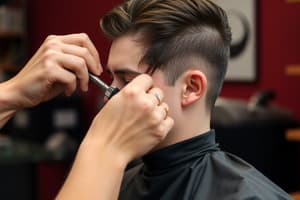Podcast
Questions and Answers
What is the foundation of every haircut?
What is the foundation of every haircut?
- Texture
- Form (correct)
- Style
- Color
Diagonal lines in haircutting create the feeling of maximum weight or stability.
Diagonal lines in haircutting create the feeling of maximum weight or stability.
False (B)
What angle of projection creates a solid form?
What angle of projection creates a solid form?
0 degree
What is a uniformly layered form also known as?
What is a uniformly layered form also known as?
What do shears create?
What do shears create?
Which finger should be placed in the finger grip of shears for control?
Which finger should be placed in the finger grip of shears for control?
Taper shears are used primarily to remove bulk.
Taper shears are used primarily to remove bulk.
What is the purpose of the guard when using electric clippers?
What is the purpose of the guard when using electric clippers?
What does the area all around the hairline refer to?
What does the area all around the hairline refer to?
What does sectioning refer to in haircutting?
What does sectioning refer to in haircutting?
What is the purpose of cross-checking in haircutting?
What is the purpose of cross-checking in haircutting?
What is the role of texturizing in haircutting?
What is the role of texturizing in haircutting?
What angle represents low projection in hair cutting?
What angle represents low projection in hair cutting?
What should you never do around the hairline?
What should you never do around the hairline?
What is a widow's peak?
What is a widow's peak?
What is the effect of cutting hair in a tilted forward position?
What is the effect of cutting hair in a tilted forward position?
What determines the size of a parting in haircutting?
What determines the size of a parting in haircutting?
What is conversion layering used for?
What is conversion layering used for?
Flashcards are hidden until you start studying
Study Notes
Haircutting Fundamentals
- Form is the foundation of every haircut, emphasizing shape and structure.
- Horizontal lines are parallel to the horizon, creating stability and maximum weight.
- Diagonal lines in haircutting create movement and excitement, enhancing the overall aesthetic.
Hair Cutting Techniques
- Cutting at 0-degree projection yields a solid form; a 45-degree cut results in a graduated appearance.
- A uniformly layered cut is defined by a 90-degree cut, featuring a circular shape and consistent length.
Tools and Their Functions
- Shears create a clean, blunt edge while razors provide a softer, tapered finish.
- Control of shears involves placing the ring finger in the grip and using the thumb for the moveable blade.
Proper Handling of Tools
- To safely hold both comb and shears in one hand, release the thumb grip and close the palm over the shears.
- Guards on electric clippers ensure an even cut for uniform hair length, while trimmers refine hairlines.
Haircutting Techniques and Concepts
- Moveable clippers' blades shift side to side during use, while a barber comb aids in controlling perimeter lengths.
- The hairline area is known as the perimeter, with the apex marking the top of the head.
Sectioning and Positioning
- Sectioning divides the head for manageable cutting, while an upright posture promotes natural-looking lines.
- Tilting the head forward while cutting leads to a slight graduated effect.
Projection and Design Lines
- Projection or elevation describes the angle the hair is held before cutting; angles below 90 degrees create weight.
- A stationary design line directs all lengths, whereas a mobile design line is used for varied lengths in cuts.
Texturizing Techniques
- Texturizing involves cutting shorter lengths within a form to reduce bulk without shortening overall length.
- End texturizing targets hair ends for softness, mobility, and blending weight lines, particularly for coarse hair.
Considerations for Curly and Growth Patterns
- Texturizing curly hair should be done dry for better control and to accommodate shrinkage.
- Allow extra length around growth patterns like widow's peaks and cowlicks for a more harmonious cut.
Density and Hair Control Measures
- Parting size in haircutting is dictated by hair density to manage the cutting process effectively.
- Infection control measures necessitate disposal of cut hair before blow drying to maintain cleanliness.
Advanced Techniques
- Conversion layering creates increased-layered forms, with higher projection angles leading to steeper inclines in graduation.
Studying That Suits You
Use AI to generate personalized quizzes and flashcards to suit your learning preferences.




